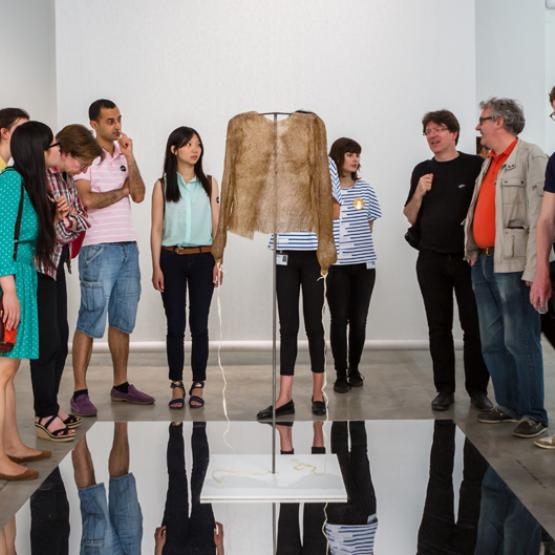Nov 15th, 2016, 03:41 PM
Carte Blanche: Art of Encounter

Carte Blanche to Tino Sehgal, Palais de Tokyo
Tino Sehgal's show at the Palais de Tokyo takes us on a remarkable journey into human interaction.
Where are the hearts and souls of the people, I ask myself as I walk down the street seeing bodies, hands and eyes attached to mobile phones, lips and fingers attached to cigarettes, feet attached to shoes pacing, tuned into their own world or the world of others virtually. What about the girl standing next to me on the train, what about the bus clock we all glance at repeatedly as we stand silent waiting for the bus. I wonder, what if we spoke to one another while we stood there waiting?
So I decided to go to an exhibition with a couple of friends, Louise and Vanessa, thinking maybe art will speak to me. We went to the Palais de Tokyo to see the show "Carte Blanche to Tino Sehgal" by the Berlin-based known for his choreography-inspired "constructed situations". The New York Times described Tino Sehgal's work as "making art out of encounter". The "Carte Blanche" show took me on remarkable journey into human interaction.

Image credit: khaleejtimes.com
As we proceeded into the expo’s entrance, the first human interaction was a young girl who immediately approached us. She was dressed similar to us, there wasn’t anything alarming about the initial observation. Then she asked: "Quelle est l'énigme?"
We paused and our facial expression must have looked confused. She asked us again. I assumed she might not think we understood French, but we did understand. We glanced at each other and laughed. She then began to do a cool dance, like someone hula-hooping in slow motion, and directed us downstairs.
People were walking toward us singing and chanting phrases about nature and humans. I could not clearly grasp what I was feeling. The closer they came to us, the more they stopped and stared, the more they whispered phrases to us, the more my feelings intensified. It was not fear, or if it was fear than it could have been a fear of human interaction without distractions.
When we went upstairs to see the main exposition, my first thought was, that was cool, now let’s go observe art in silence. We stood in line where we could not see anything as we glanced into the room where the expo was taking place. This was odd, all we could see was people standing around talking to each other. When we entered, we were greeted by a young boy who asked, "What is progress?" We shuffled through the disorientation of our minds and found words to define progress. We spent a couple of minutes with him and then we were introduced to a woman. She led us into another room, there were just white walls so my attention was focused on the interaction with her.
We spoke casually, as if at a coffee shop or in a library or on a long train ride. She then introduced us to another person. We laughed and realized that we were not use to interacting with people without distractions. There was always a phone in someone’s hands, a device that tries to capture or track time.
As I was introduced to each person, I didn’t have any expectation of what we would discuss or what I should say, I was just there and we were in conversation/dialogue and there weren't any distractions. Have you ever really just talked to a stranger and it felt natural? I really enjoyed this feeling and I wondered, as Haley Jones asks: "How does social media affect interaction in our society? Will face-to-face communication ultimately diminish because of these new social technologies?"
Artist Tino Sehgal. Image credit: Palais de Tokyo
I kept thinking, I don’t get how interacting with strangers came so easily and sometimes interacting with associates or friends can be difficult. Are we distracted? I thought about the many times I have observed my own and others' frustration in trying to understand the other. The question that remains is, how do we begin to understand the other? Must we put down the devices that idealize us or cluster us into categories of information and listen?
As Tino Seghal states, "I want to bring back the human encounter into places where material things have a prime status. In a museum, you're supposed to look at things and not talk to other people."
Palais de Tokyo, Paris
Runs till Dec. 18th








